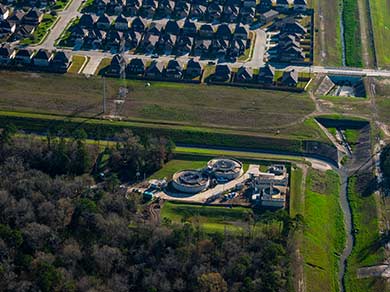MUD, PID, and TIRZ. Secret spy agencies? Obscure crossword puzzle answers? Locker combinations of the stars?
Nope. They’re modern-day vehicles that developers can use for financing necessary infrastructure like water, wastewater, and roads. According to Rick Rosenberg, managing principal for real estate development for consultant DPFG’s Texas region, “Special districts in Texas can decrease development costs, making projects more feasible and home prices more affordable.” In other words, he adds, “They make development work.”
Michael Fisher, P.E., senior vice president of Pape-Dawson Engineers, further explains that we’re seeing more special districts being created as development pushes beyond existing city infrastructure. “These districts are great tools for cities and developers to achieve growth and expand utility service to previously undevelopable land.”
When it comes to districting, Michael and Rick say there are three key acronyms to know.
MUD (Municipal Utility District)
As a funding method for infrastructure, the MUD is several decades old and has been the most utilized method in Texas, especially around Houston. Other regions feature MUDs, too, Michael says: “Pape-Dawson often serves as district engineer for MUDs in the Austin area, and about 50% of our Austin-area land development projects are within MUDs.”
MUDs help plug a gap in infrastructure funding, now that banks and investors have become less amenable to risk since the 2008-2010 recession. “Investors now require a guarantee—and will make only 50 percent of the necessary funds available,” says Rick. MUDs provide an affordable way to make up the difference between a project’s costs and the amount of bank financing.
Typically, the developer constructs the infrastructure. “That can include water, wastewater, and drainage features—and recently roads, with paving, curbs and sidewalks, signals, and maybe even some landscaping,” Michael explains. But instead of transmitting the costs to buyers through a property’s sales price, the MUD (a public entity overseen by the Texas Commission on Environmental Quality) reimburses the developer by issuing bonds supported by additional property taxes. That keeps buyers’ costs and property taxes lower.
PID (Public Improvement District)
While MUDs have been preferred in the Houston area, PIDs have bloomed along the IH 35 corridor that stretches from Dallas-Fort Worth through Austin to San Antonio.
Texas cities or counties can establish a PID at no cost to fund public improvements including roads, water, and wastewater, as well as amenities like public parks and trails. A PID offers a significant benefit to developers, as it is the one public financing mechanism in Texas used to fund construction costs directly by issuing bonds through the jurisdiction that created it. These bonds are not guaranteed by the jurisdiction.
Without a financing vehicle like a PID, a developer must pay up front for infrastructure and then pass those costs (along with a markup) to the consumer. “A PID or MUD can help houses to sell at an affordable price,” says Rick. “It can allow a builder to sell a home for $290,000 with a PID, rather than $350,000 or more without one.” The lower sales price means buyers also pay less in down payments and property taxes.
To pay for the public improvements, the PID assesses an annual, predictable fee to homeowners. The fee rarely goes up, and can be paid off early, like a mortgage.
Jurisdictions often prefer PIDs, too, since they grant significant leverage. “If there is a goal of more affordable housing, for example,” Rick says, “they might negotiate to receive 10 percent of the value of every PID bond issued to be used for that purpose. Or they might agree that 10 percent of PID acreage be designated for affordable housing.”
Jurisdictions have won concessions on a wide range of issues, including amenities (high-speed broadband and public-accessible parks), environmental concerns (public sewer instead of septic tanks or public water instead of wells), and aesthetics (mature trees, wider streets, and design standards). Medina County approved a PID by making lot size requirements for a development, for example. “In the end, cities and counties have found PIDs can give them a seat at the table,” Rick explains. For this reason, and the fact that MUDs are controlled by the developer, even the Houston area is beginning to prefer PIDs.
TIRZ (Tax Increment Reinvestment Zone)
A TIRZ is another mechanism for infrastructure, but it is typically used for commercial projects. “You’ll see it with an expectation for job creation,” Rick says. Developers pay infrastructure costs up front and are repaid from the increased taxes generated. TIRZ funding usually pays for capital improvements, and the payback timeline and amount are both limited. After full repayment of the TIRZ improvements, taxes can again flow wholly to the jurisdictions.
These funding vehicles are not just for big metros. “We’re educating clients all over Texas. There’s interest in Laredo, Waco, and plenty of other places,” Rick says. Wherever you are, the key is education, according to Rick. Know the details of each funding mechanism, find out how they work, and choose the one that best fits your development.
Then the acronyms become more than letters. They become communities.
Download the article here: Industry Insights_2021-Issue3_DistrictingAlphabetSoup
